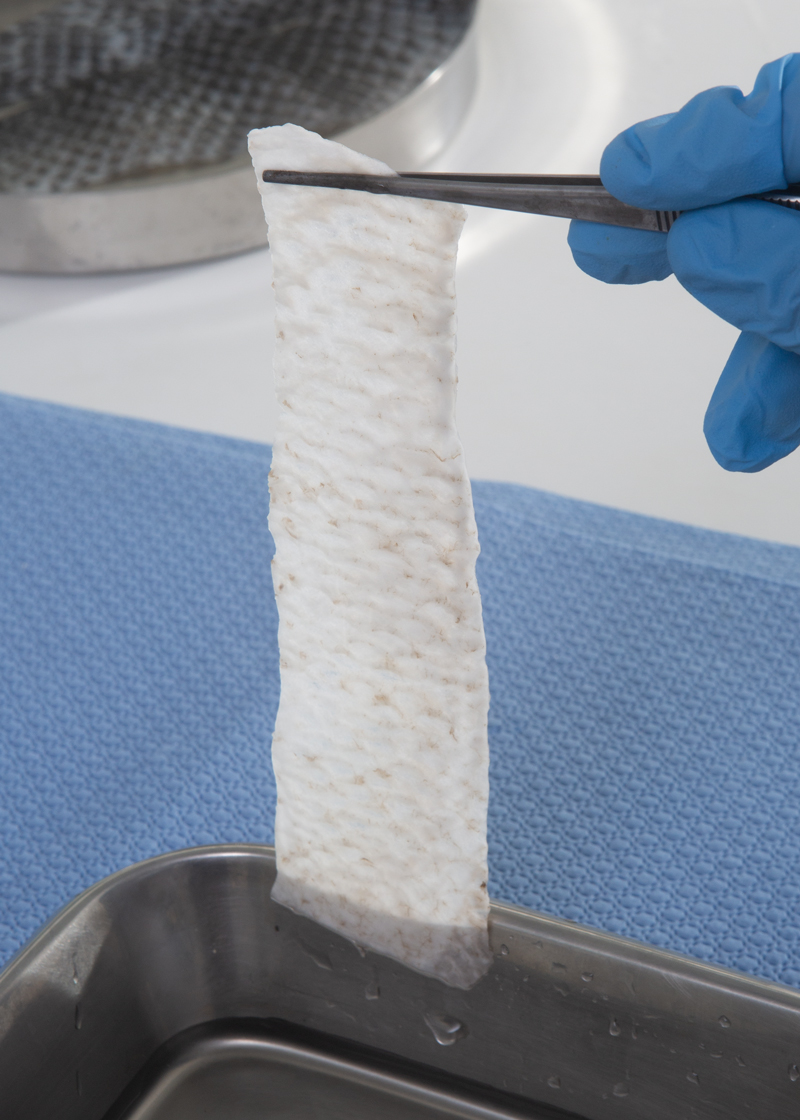A new surgical technique using a biotissue graft derived from the skin of Nile tilapia (Oreochromis nicoticus), a freshwater species commonly found in Brazil, is helping to restore vision in dogs suffering from ulcers or severe corneal injuries, including perforations. The graft, a membrane rich in collagen that aids in tissue repair, was developed by researchers from the Drug Production and Development Center at the School of Medicine of the Federal University of Ceará (NPDM-UFC). The graft is used as a postsurgical dressing to promote the regeneration, or re-epithelialization, of the cornea and accelerate the healing process.
“Over the past four years, we have successfully restored eye health in more than 400 dogs using our new technique,” says veterinarian Mirza Melo, the lead researcher in the study. “The membrane, technically an acellular dermal matrix, functions as a ‘scaffold,’ protecting the cornea and stimulating cell production in affected areas. It gradually releases collagen and is later absorbed by the body.” Melo explains that brachycephalic dogs, such as bulldogs, pugs, lhasa apsos, and shih-tzus, with their shorter snouts and prominent and protruding eyes, are particularly susceptible to corneal injuries.
The biotissue is produced in a lab by removing the scales and all cellular components from the fish skin, leaving behind only the collagen. “While there are biological membranes available in the market, produced from cows or pigs, they are typically imported. The advantage of our approach is that it uses a byproduct from the local fishing industry and a fish species widely cultivated in the region, which lowers costs.”

Christian Montes / Pexels | Steshka Willems / Pexels | Alexas-Fotos / PexelsBrachycephalic breeds such as bulldogs, shih-tzus, lhasa apsos, and pugs are particularly susceptible to eye injuriesChristian Montes / Pexels | Steshka Willems / Pexels | Alexas-Fotos / Pexels
Melo first reported on the use of dermal matrices from tilapia skin in eye surgeries in a thesis for his master’s degree in Translational Medicine, under the supervision of physician Manoel Odorico de Moraes Filho, who heads NPDM. In a study involving 60 dogs with corneal injuries, Melo compared the performance of his fish-derived matrix to a commercially available membrane derived from porcine intestinal mucosa and a conjunctival graft from the patient’s own tissue. “Our dermal matrix proved to be superior, resulting in reduced healing time and faster recovery,” Melo says. The experimental leg of the research was conducted at Centro de Olhos Veterinário, a private veterinary clinic specializing in eye care, under Melo’s supervision.
A report on the first animal to be treated using the new technique, a shih-tzu dog with poked eye, was published in the Brazilian Journal of Animal and Environmental Research in 2022. “The report showed improved corneal tissue repair under the tilapia skin graft, including increased transparency, absence of melanosis [spots], low vascularization, and good lubrication,” noted the authors. This first case was presented at the Brazilian Congress of Veterinary Ophthalmology near the end of 2021, receiving the award for top presentation at the event.
Melo, who is a professor at the State University of Ceará (UECE) and is currently pursuing a doctoral degree at UFC, conducted her research as part of a broader study on medical applications for tilapia skin. The study, initiated in 2014 in Ceará, is led by plastic surgeon Edmar Maciel from NPDM-UFC and the Burn Treatment Institute (IAQ) in Fortaleza. Experimental use of freeze-dried, sterilized, gamma-irradiated, and vacuum-packed fish skin has proven effective as a biological dressing for burn treatment, vaginal canal reconstruction for patients undergoing gender reassignment surgery, and finger tissue repair in children with Apert syndrome, a rare condition in which patients’ fingers are webbed or conjoined (see Pesquisa FAPESP issue nº 280).
“We began developing acellular dermal matrices from tilapia skin in 2018. Since then, we’ve conducted a series of characterization and production tests in the lab,” explains Maciel, adding that the use of biotissue is being researched in over a dozen medical specialties, including urology, cardiology, general surgery, and neurology. “In addition to Melo’s work in veterinary ophthalmology, one of the most advanced research programs within the group is related to cranial surgeries [see sidebar].”
The chemical, biological, and morphological analyses of the dermal matrix were led by biochemist Carlos Roberto Koscky Paier, a pharmacology professor at UFC, and biologist Felipe Augusto Rocha Rodrigues from the Federal Institute of Education, Science, and Technology of Ceará (IFCE). The pair are exploring a range of new medical applications for tilapia skin.
“We developed the dermal matrix graft using a similar approach to the one used to make the biological dressing from freeze-dried skin. We needed to standardize a chemical, biochemical, and enzymatic method for removing cellular content from the skin tissue while causing minimal damage to the collagen-rich extracellular matrix,” Paier explains. “To accomplish this, we tested various decellularization methods using different biocompatible detergents.”

Chico Gadelha/Revista Pesquisa FAPESPA cellular dermal matrix in the foreground (white strip) and tilapia skin in the backgroundChico Gadelha/Revista Pesquisa FAPESP
They then performed histological analyses of the membrane under an optical microscope to examine its morphology, and used fluorescence microscopy to estimate the number of removed cells. “We also extracted DNA from the fresh skin and the acellular matrix, following the cell removal process, to quantify the remaining DNA. We achieved what we consider to be a satisfactory reduction of over 90%.”
The team conducted tensile tests to compare the strength of the dermal matrix to fish skin. These tests showed a minor loss of tensile strength in the collagen membrane, but one that would not affect its suitability as a biocompatible protein matrix. Cytotoxicity studies followed. As the material is derived from a free-living animal exposed to potential contamination by various microorganisms, it is chemically decontaminated before decellularization, a process that could potentially leave toxic residue in the proteins of the extracellular matrix.
“We had to develop a detoxification process at the histological level. Cytotoxicity tests involving indirect contact with the biomaterial confirmed effectiveness,” explains Paier, who has done doctoral research on cardiac proteins at the Brazilian Center for Research in Energy and Materials (CNPEM) in Campinas, with funding from FAPESP.
After successful experiments with the graft material in dogs, the researchers are now refining the matrix for potential human applications. “In 2021, we were invited by the organizers of the Ceará Ophthalmology Congress and presented our membrane,” says Melo. The researchers plan to start human trials in the near future.
Flávio Vieira Meirelles, a veterinarian and professor at the School of Animal Science and Food Engineering at the University of São Paulo (FZEA-USP), who was not involved in the research at UFC, says collagen-rich acellular dermal matrices hold promise in veterinary treatments given their ability to promote cell migration in damaged tissue.
“Membranes extracted from tilapia skin help to protect the wound and keep it moist, stimulating regeneration. The treated tissue, such as corneal tissue in pets, begins to naturally rebuild,” Meirelles explains. “While the research with tilapia skin is significant, there are other research groups in São Paulo and across Brazil who are now working with various types of decellularized tissues, such as amniotic membranes derived from placenta for veterinary treatments. Other well-established techniques include the use of animal-derived membranes in heart valve replacements, already widely used in humans.”
Researchers are testing the use of acellular dermal matrices in reconstructing the membrane lining the brain
A separate research leg is testing cellular dermal matrices from tilapia skin in cranial surgeries to treat disease or injuries by reconstructing the dura mater membrane of the brain — the outermost of the three meninges that surround the brain and the central nervous system. This study is led by a group headed by neurosurgeon Rodrigo Becco, a doctoral student in translational medicine at UFC.
“We synthesized the membranes and, following in vitro tests, selected some for animal trials,” reports Becco. In tests with rats, the researcher operated on 36 animals, divided into three groups. In the first group, he used a reference, goal-standard membrane commercially available in Brazil and worldwide and approved by the Brazilian Health Regulatory Agency (ANVISA), the Food and Drug Administration (FDA), and the European Union. The collagen-rich matrix from tilapia skin was used on the second group, while in the third group, the animals underwent only a craniectomy, removing a part of the cranial vault bone without placing a membrane in the area.
According to Becco, the dermal matrix from tilapia skin closely resembles the dura mater in terms of thickness and flexibility. “Initial results have shown it does not trigger an inflammatory process. It is quite malleable and a very effective mechanical barrier, even more so than the gold-standard membrane,” Becco reports.
“We have now applied for permission from the school’s Ethics Committee to conduct trials on humans to assess whether the positive outcomes observed in animals are replicated,” he concludes.
Jayne Oliveira
Scientific article
MELO, M. S. et al. Enxerto de pele de tilápia (Oreochromis niloticus) em reparo de úlcera em córnea de cão: Relato de caso. Brazilian Journal of Animal and Environmental Research. Vol. 5, no. 1, pp. 367–75. Jan./Mar. 2022.


